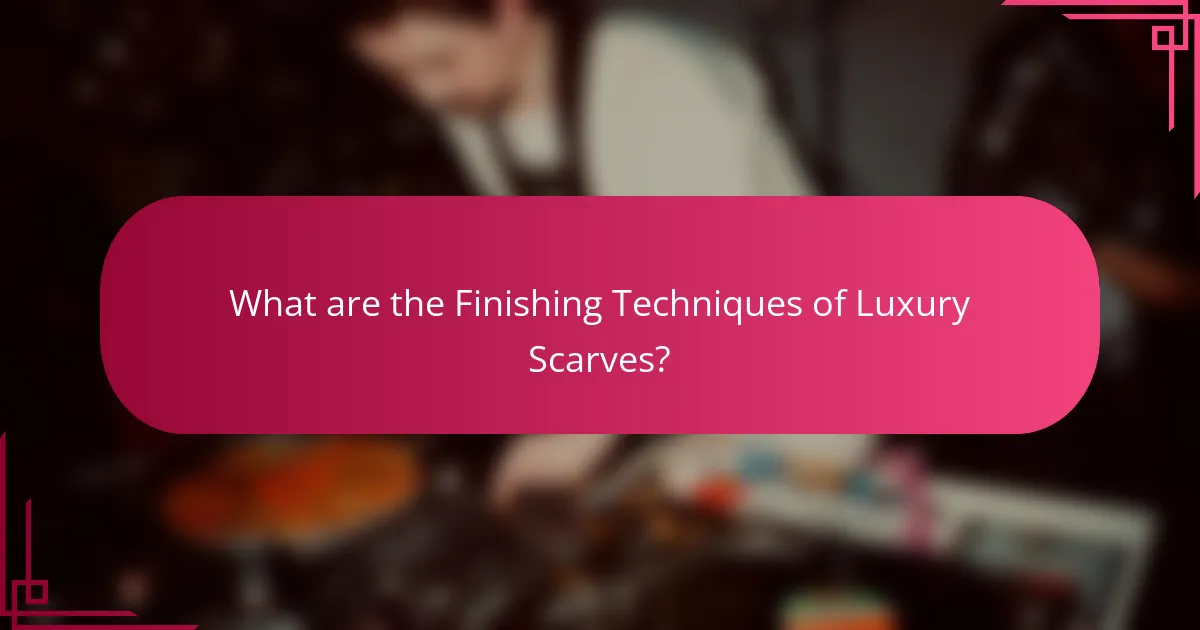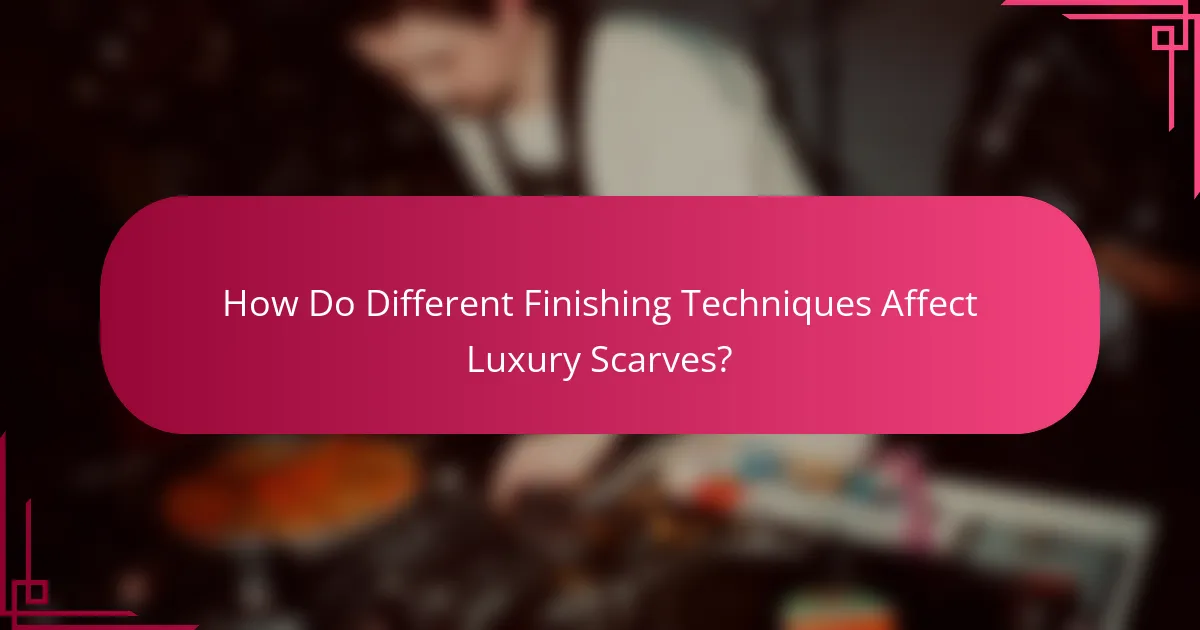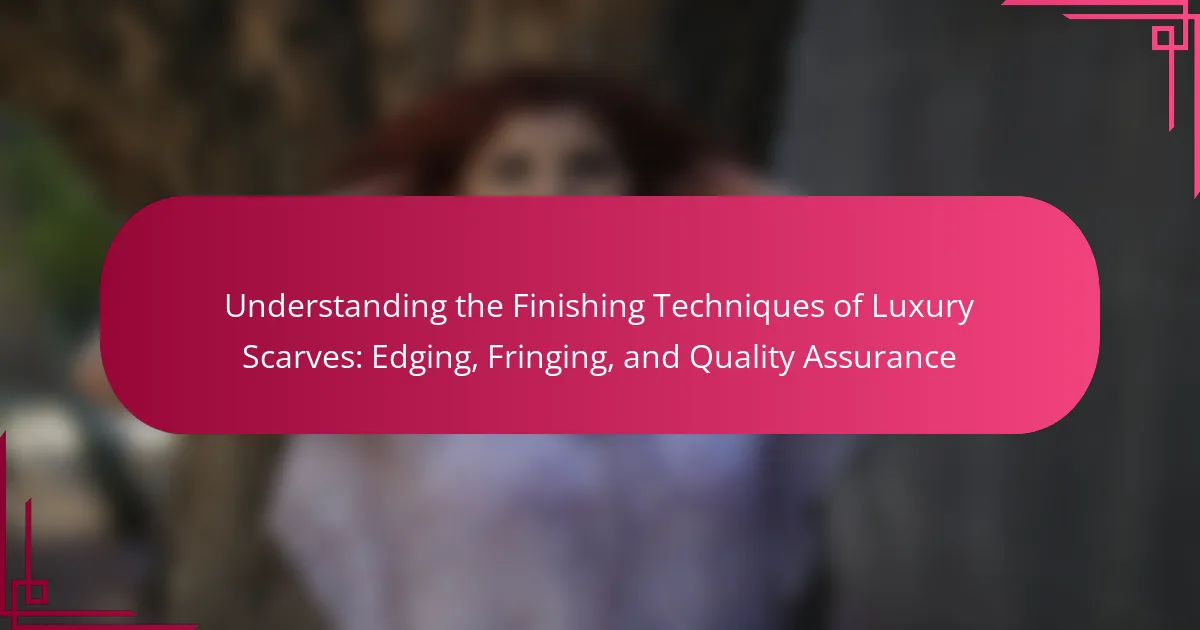Luxury scarves are defined by their sophisticated finishing techniques, which include edging, fringing, and rigorous quality assurance processes. Edging methods such as rolled hems and hand-stitched finishes enhance the visual appeal and durability of these accessories. Fringing adds texture and movement, while quality assurance ensures that each scarf meets high craftsmanship standards. The choice of materials, design uniqueness, and meticulous craftsmanship are critical factors in selecting luxury scarves, as they influence both aesthetic appeal and functionality. High-quality scarves made from premium fabrics like silk and cashmere exemplify the intersection of fashion and durability, making them versatile additions to any wardrobe.

What are the Finishing Techniques of Luxury Scarves?
The finishing techniques of luxury scarves include edging, fringing, and quality assurance processes. Edging can be done through various methods such as rolled hems, bias binding, or hand-stitched finishes. Fringing involves creating tassels or raw edges to enhance texture and style. Quality assurance ensures that each scarf meets high standards in craftsmanship and material. These techniques contribute to the overall aesthetic and durability of luxury scarves.
How do Edging Techniques Enhance Luxury Scarves?
Edging techniques enhance luxury scarves by adding refined finishes that elevate their aesthetic appeal. These techniques include hand-rolled edges, which provide a soft, elegant look. Additionally, machine-stitched edges ensure durability while maintaining a polished appearance. Edging can also incorporate decorative elements like piping or contrasting colors, enhancing visual interest. The quality of the edging reflects craftsmanship, which is crucial in luxury fashion. High-quality edging techniques can increase the perceived value of the scarf. This is supported by the fact that luxury brands invest in meticulous finishing to distinguish their products in the market.
What are the different types of edging techniques used in luxury scarves?
The different types of edging techniques used in luxury scarves include hemmed edges, rolled edges, and fringed edges. Hemmed edges are created by folding the fabric and sewing it down, providing a clean and polished look. Rolled edges involve rolling the fabric to create a soft, rounded finish, often used in silk scarves for a delicate appearance. Fringed edges feature loose threads that add texture and a bohemian flair to the scarf. Each technique enhances the scarf’s aesthetic and durability, contributing to its overall luxury appeal.
How does the choice of edging affect the overall look of a scarf?
The choice of edging significantly influences the overall look of a scarf. Different edging techniques can create distinct visual effects and styles. For instance, a rolled hem offers a sleek, polished appearance. In contrast, a fringed edge adds a casual, bohemian touch. Additionally, contrasting colors in the edging can enhance the scarf’s design and make it more eye-catching. The material used for edging also affects texture and drape. High-quality edging can elevate a scarf’s luxury feel, while poorly executed edging may detract from its appeal. Overall, edging serves as a crucial element in defining a scarf’s aesthetic and style.
What Role Does Fringing Play in Luxury Scarves?
Fringing plays a decorative and functional role in luxury scarves. It enhances the aesthetic appeal by adding texture and visual interest. Fringing also provides a refined finish that can elevate the overall design. Additionally, it can help to prevent fraying at the edges of the fabric. Luxury scarves often feature meticulously crafted fringes that showcase artisanal skill. High-quality materials are typically used to ensure durability and elegance. The presence of fringing can signify attention to detail, a hallmark of luxury fashion. Overall, fringing contributes significantly to both the style and quality of luxury scarves.
What are the various styles of fringing found in luxury scarves?
Luxury scarves feature various styles of fringing, including tassel, knotted, and fringed edges. Tassel fringing consists of decorative knots that hang from the ends of the scarf. Knotted fringing involves tying the fabric into small knots for texture and visual interest. Fringed edges are created by unraveling the fabric’s threads to form a soft, textured finish. Each style enhances the scarf’s aesthetic appeal and can be made from different materials, such as silk, wool, or cashmere. The choice of fringing style often reflects the scarf’s overall design and intended use.
How does fringing contribute to the texture and appeal of a scarf?
Fringing enhances the texture and appeal of a scarf by adding dimension and visual interest. The strands of fringe create a tactile quality that invites touch. This texture contrasts with the smooth surface of the scarf, enriching the overall sensory experience. Additionally, fringing can introduce movement, making the scarf more dynamic as it flows. The visual effect of fringing can also draw attention, elevating the scarf’s aesthetic value. Various materials used in fringing can further influence its softness or stiffness. For instance, silk fringe offers elegance, while wool fringe provides warmth. Consequently, fringing serves both functional and decorative purposes, making scarves more versatile accessories.
Why is Quality Assurance Important in Luxury Scarves?
Quality assurance is crucial in luxury scarves to ensure superior craftsmanship and material integrity. High-quality scarves reflect brand reputation and customer expectations. Rigorous quality checks prevent defects that could compromise the product’s elegance and durability. This process involves inspecting fabric, stitching, and finishing techniques. Ensuring consistency in quality enhances customer satisfaction and loyalty. According to a 2021 study by Textile Research Journal, quality assurance directly correlates with customer retention in luxury goods. Thus, maintaining high standards in luxury scarves is essential for brand success.
What are the key quality assurance processes for luxury scarves?
The key quality assurance processes for luxury scarves include material inspection, craftsmanship evaluation, and final product testing. Material inspection ensures that only the highest quality fabrics are used. This process verifies the texture, color consistency, and durability of the materials. Craftsmanship evaluation assesses the skill involved in the production. It examines stitching, finishing techniques, and overall attention to detail. Final product testing involves checking for defects and verifying that the scarf meets brand standards. This includes evaluating the weight, drape, and feel of the scarf. These processes collectively uphold the luxury status of the scarves.
How does quality assurance impact the longevity of luxury scarves?
Quality assurance significantly enhances the longevity of luxury scarves. It involves rigorous testing and inspection processes that ensure high-quality materials are used. Quality assurance also verifies that the production methods meet industry standards. This reduces the likelihood of defects and increases durability. For instance, scarves made from premium silk or cashmere undergo quality checks for strength and resilience. As a result, these scarves maintain their appearance and functionality over time. Additionally, quality assurance can prevent issues like fraying or fading, which are common in lower-quality products. Overall, effective quality assurance leads to longer-lasting luxury scarves, ensuring customer satisfaction and brand reputation.

How Do Different Finishing Techniques Affect Luxury Scarves?
Different finishing techniques significantly affect luxury scarves by influencing their aesthetic appeal and durability. Techniques such as edging enhance the scarf’s overall appearance, providing a polished look. Fringing adds texture and movement, creating a more dynamic accessory. Quality assurance measures ensure that the finishing techniques meet high standards, contributing to the scarf’s longevity. For instance, hand-rolled edges are a hallmark of luxury, indicating meticulous craftsmanship. The choice of finishing can also affect the drape and comfort of the scarf. Scarves with quality finishes are often more resistant to fraying and wear. Overall, these techniques play a crucial role in defining the luxury status of scarves.
What are the visual effects of various edging techniques?
Various edging techniques create distinct visual effects on luxury scarves. Techniques like rolled hems provide a smooth, polished finish. This enhances the scarf’s elegance and sophistication. Flat hems offer a clean, minimalistic look. They are often used for a contemporary style. Fringing adds texture and movement, creating a casual and playful appearance. Piping can introduce contrast, highlighting the scarf’s shape and design. Each technique influences the overall aesthetic, contributing to the scarf’s appeal. The choice of edging can significantly affect how the scarf is perceived in terms of luxury and style.
How do different materials influence the effectiveness of edging?
Different materials significantly influence the effectiveness of edging in luxury scarves. Natural fibers like silk and cotton provide a soft, luxurious finish that enhances drape and flow. Synthetic materials such as polyester can offer durability and resistance to fraying, but may lack the same aesthetic appeal. The choice of material affects how well the edging holds up over time. For instance, silk edges may require more delicate handling to prevent damage. In contrast, cotton can withstand more wear and tear. The effectiveness of edging also depends on the material’s weight and texture, which can impact the overall look and feel of the scarf.
What is the relationship between edging and scarf functionality?
Edging enhances scarf functionality by providing structural integrity. Proper edging prevents fraying and maintains the scarf’s shape over time. It also contributes to the overall aesthetic appeal, making the scarf more visually appealing. High-quality edging techniques can signify craftsmanship and luxury. For instance, hand-stitched edges are often more durable than machine-stitched ones. This durability ensures that the scarf can withstand regular use without losing its form. Furthermore, effective edging can improve the comfort of wearing the scarf, as it eliminates rough edges. Overall, edging plays a crucial role in both the practicality and style of luxury scarves.
How does fringing vary across different luxury scarf brands?
Fringing varies significantly across different luxury scarf brands in terms of style, material, and craftsmanship. For instance, brands like Hermès often utilize hand-rolled fringing, which adds a refined and artisanal touch. In contrast, brands such as Burberry may employ machine-finished fringing for a more uniform appearance. The choice of materials also influences fringing; cashmere scarves typically feature softer, more delicate fringing compared to wool or silk blends. Additionally, some brands incorporate unique design elements into their fringing, such as contrasting colors or intricate patterns, enhancing the overall aesthetic. This diversity in fringing techniques reflects each brand’s identity and commitment to quality craftsmanship in luxury scarves.
What unique fringing styles are offered by high-end brands?
High-end brands offer unique fringing styles such as hand-knotted, twisted, and layered fringes. Hand-knotted fringes provide a artisanal touch, showcasing craftsmanship. Twisted fringes create texture and movement, enhancing the visual appeal. Layered fringes add depth and dimension to luxury scarves. These styles are often made from high-quality materials like silk and cashmere. Brands like Hermès and Chanel are known for their distinctive fringing techniques. Their scarves often feature intricate designs that highlight these unique styles. Each fringing style contributes to the overall aesthetic and luxury of the product.
How does brand reputation influence the quality of fringing?
Brand reputation significantly influences the quality of fringing in luxury scarves. A strong brand reputation often correlates with higher standards in material selection and craftsmanship. Brands known for quality invest in skilled artisans who ensure precise fringing techniques. This attention to detail results in more durable and aesthetically pleasing finishes. Research indicates that consumers associate brand reputation with product quality, impacting their purchasing decisions. For instance, a study by the Journal of Brand Management found that perceived quality enhances customer loyalty. Thus, reputable brands are more likely to deliver superior fringing quality in their products.

What Are the Best Practices for Selecting Luxury Scarves?
To select luxury scarves effectively, prioritize material quality, design, and craftsmanship. High-end scarves are often made from premium fabrics like silk, cashmere, or wool. Examine the texture; a soft, smooth feel indicates quality. Evaluate the design for uniqueness and aesthetic appeal. Look for intricate patterns or prints that reflect artistry. Inspect craftsmanship by checking stitching and finishing details. Neat, even stitching suggests attention to detail. Consider the brand’s reputation for luxury and quality. Established brands often guarantee superior products. Finally, assess the scarf’s versatility for styling with different outfits. A well-chosen luxury scarf enhances both fashion and function.
How can consumers assess the quality of finishing techniques?
Consumers can assess the quality of finishing techniques by examining the precision and consistency of the edges. High-quality finishes should have clean, even edges without fraying. Consumers should also check for uniformity in color and texture throughout the scarf. The stitching should be tight and secure, with no loose threads. Additionally, consumers can evaluate the material used in the finishing process. Premium materials often indicate better craftsmanship. A well-finished scarf will also retain its shape and not show signs of wear after minimal use. These factors collectively contribute to the overall perception of quality in finishing techniques.
What signs indicate high-quality edging and fringing?
High-quality edging and fringing exhibit several distinct signs. First, the stitching should be even and tight, preventing fraying. Additionally, premium materials like silk or cashmere are often used, enhancing durability. The edges should be smooth and well-finished, showing no rough spots. Consistent color matching between the fringe and the scarf indicates attention to detail. High-quality fringing typically features a uniform length and density. Lastly, a luxurious feel and drape of the fabric contribute to the overall quality perception. These characteristics collectively signify superior craftsmanship in edging and fringing.
How can one determine the durability of a luxury scarf’s finish?
To determine the durability of a luxury scarf’s finish, examine the quality of the materials used. High-quality fabrics like silk or cashmere typically indicate better durability. Inspect the stitching; tight, even stitches suggest a well-finished product. Check for fraying or loose threads, which can compromise longevity. Evaluate the scarf’s treatment against wear and tear; finishes like serging or rolled hems offer more resilience. Additionally, consider the brand reputation; established luxury brands often use superior finishing techniques. Reviews and customer feedback can provide insights into the durability of specific finishes.
What tips should be considered when caring for luxury scarves?
To care for luxury scarves, always follow specific guidelines. Hand wash or dry clean to avoid damage. Use cold water and mild detergent for washing. Air dry flat to maintain shape and avoid wrinkles. Store in a cool, dry place away from direct sunlight. Avoid hanging to prevent stretching. Rotate usage to minimize wear. Use a silk or fabric pouch for storage to prevent snagging. Regularly check for any signs of wear or damage. These practices help preserve the quality and longevity of luxury scarves.
How does proper care affect the longevity of edging and fringing?
Proper care significantly enhances the longevity of edging and fringing in luxury scarves. Regular cleaning prevents dirt accumulation that can weaken fibers. Using appropriate detergents maintains color and texture. Proper storage avoids creasing and tangling, which can damage delicate edges. Additionally, gentle handling during wear minimizes wear and tear. Research indicates that textiles maintained under optimal conditions can last up to 50% longer. This emphasizes the importance of care in preserving the quality of edging and fringing.
What maintenance practices help preserve the quality of luxury scarves?
To preserve the quality of luxury scarves, proper maintenance practices are essential. Regularly storing scarves in a cool, dry place helps prevent damage. Avoiding exposure to direct sunlight minimizes fading and discoloration. Gentle hand washing with mild detergent is recommended for cleaning. Air drying flat prevents distortion of shape and fabric. Avoiding harsh chemicals and bleach protects the fibers. Ironing on a low heat setting maintains the fabric’s integrity. Using a silk or wool-specific garment bag during storage protects against dust and pests. Following these practices can extend the lifespan and appearance of luxury scarves.
The main entity of this article is luxury scarves, specifically focusing on their finishing techniques, including edging, fringing, and quality assurance processes. The article provides an in-depth examination of various edging techniques and their impact on the aesthetic appeal and durability of scarves, as well as the role of fringing in enhancing texture and visual interest. Additionally, it discusses the importance of quality assurance in maintaining high standards of craftsmanship and material integrity, along with best practices for selecting and caring for luxury scarves. Key insights into the relationship between brand reputation and the quality of finishing techniques are also highlighted, emphasizing the significance of meticulous attention to detail in luxury fashion.
